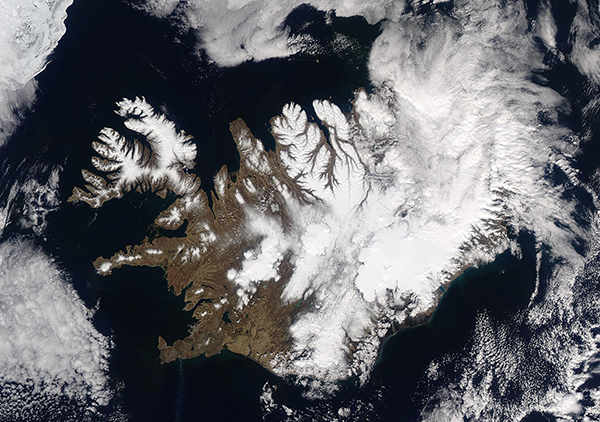Images
May 9, 2021 - Magical May in Iceland
Tweet
The lengthening sunshine of May brings spring magic to Iceland: warming temperatures, melting snow, flowers in bloom, the return of the puffins, and new lambs frolicking in greening fields. This year, Fagradalsfjall volcano added a little extra magic to the month with an outburst of pulsing lava fountains.
On March 19, 2021, Iceland gained a new volcano when Fagradalsfjall erupted for the first time in recorded history. On that date, a large fissure vent formed and began ejecting lava, which flowed steadily across the landscape. Several new fissures opened in April. On May 4, two new volcanic fissures opened close to the initial eruption site, each measuring about 200 meters (656 feet) long. On May 5, the Icelandic Met Office reported that the eruption in Fagradalsfjall continued through one main crater. The active crater was the fifth fissure that opened in the area on the 13th of April.
Continuous lava fountains characterized the eruption beginning on April 27, but from May 2 the behavior has been pulsating. The Icelandic Met Office offers this description: “These pulses have intermittent active periods of 8-12 minutes, with 1-2 minutes of rest periods in between. The active pulses start with a strong fountain activity, with fountains reaching up to 100-150 m above ground level, and some even higher. These pulses are very apparent in the seismic tremor from seismic stations in a wide area around the eruption site.”
The Moderate Resolution Imaging Spectroradiometer (MODIS) on board NASA’s Aqua satellite acquired a true-color image of Iceland on May 4. Spring thaw was well underway, leaving much of the west and coastal north snow-free. The Reykjanes Peninsula, home to Fagradalsfjall volcano, protrudes into the Atlantic Ocean from the southwestern corner of Iceland. It is here, near the southern coast of the Reykjanes Peninsula, and about 25 miles (40 km) from the city of Reykjavik, that a gray plume of volcanic ash rises from the volcano and drifts southward over the Atlantic. This plume appears faint at the lowest (1 km) resolution but can be easily viewed at high (250 km) resolution.
Image Facts
Satellite:
Aqua
Date Acquired: 5/4/2021
Resolutions:
1km (335.6 KB), 500m (998.2 KB), 250m (2.7 MB)
Bands Used: 1,4,3
Image Credit:
MODIS Land Rapid Response Team, NASA GSFC
Tweet
The lengthening sunshine of May brings spring magic to Iceland: warming temperatures, melting snow, flowers in bloom, the return of the puffins, and new lambs frolicking in greening fields. This year, Fagradalsfjall volcano added a little extra magic to the month with an outburst of pulsing lava fountains.
On March 19, 2021, Iceland gained a new volcano when Fagradalsfjall erupted for the first time in recorded history. On that date, a large fissure vent formed and began ejecting lava, which flowed steadily across the landscape. Several new fissures opened in April. On May 4, two new volcanic fissures opened close to the initial eruption site, each measuring about 200 meters (656 feet) long. On May 5, the Icelandic Met Office reported that the eruption in Fagradalsfjall continued through one main crater. The active crater was the fifth fissure that opened in the area on the 13th of April.
Continuous lava fountains characterized the eruption beginning on April 27, but from May 2 the behavior has been pulsating. The Icelandic Met Office offers this description: “These pulses have intermittent active periods of 8-12 minutes, with 1-2 minutes of rest periods in between. The active pulses start with a strong fountain activity, with fountains reaching up to 100-150 m above ground level, and some even higher. These pulses are very apparent in the seismic tremor from seismic stations in a wide area around the eruption site.”
The Moderate Resolution Imaging Spectroradiometer (MODIS) on board NASA’s Aqua satellite acquired a true-color image of Iceland on May 4. Spring thaw was well underway, leaving much of the west and coastal north snow-free. The Reykjanes Peninsula, home to Fagradalsfjall volcano, protrudes into the Atlantic Ocean from the southwestern corner of Iceland. It is here, near the southern coast of the Reykjanes Peninsula, and about 25 miles (40 km) from the city of Reykjavik, that a gray plume of volcanic ash rises from the volcano and drifts southward over the Atlantic. This plume appears faint at the lowest (1 km) resolution but can be easily viewed at high (250 km) resolution.
Image Facts
Satellite:
Aqua
Date Acquired: 5/4/2021
Resolutions:
1km (335.6 KB), 500m (998.2 KB), 250m (2.7 MB)
Bands Used: 1,4,3
Image Credit:
MODIS Land Rapid Response Team, NASA GSFC




